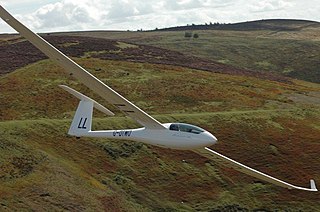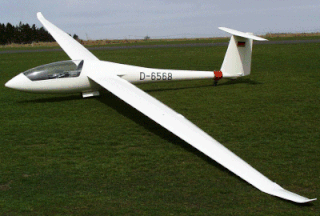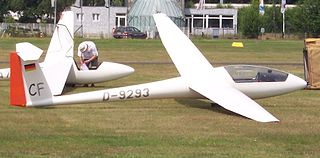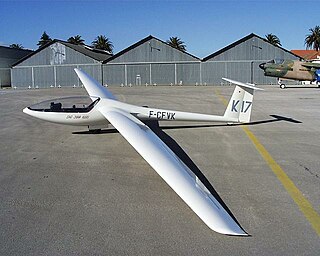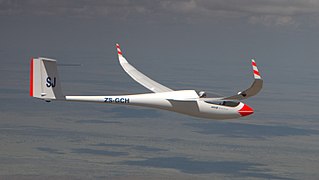Development
By the mid–to–late eighties the LS4 had lost its leading position in the Standard Class to new arrivals, in particular the excellent Discus from Schempp-Hirth. The LS7, in spite of its advanced design, did not recapture the lead and, with flagging sales, Rolladen-Schneider went back to the drawing board.
Designer Wolf Lemke was skeptical of the usefulness of developing a new airfoil. There was no guarantee that the large effort and investment required would bring any palpable gains, as the LS7, ASW 24 and DG-600 had clearly shown. The tools available at the time were simply not up to the task of reliably predicting the performance in everyday conditions of the newer laminar-flow profiles then emerging from the research labs.
The 15–meter Class LS6, which first flew in 1983, was however achieving surprisingly good results flying with locked flaps in the non-FAI sanctioned Sports Class in the United States. Following this lead, Rolladen-Schneider modified an LS6-c by removing the flap handle, resetting the wing at a slightly higher angle of incidence and adding winglets. This experimental prototype outperformed state-of-the-art standard class sailplanes both in side-by-side flight tests and in contests including the German Championships at Neustadt-Glewe.
The LS8 that finally emerged in 1994 had a few improvements over the prototype, the most significant being the redesigned ailerons and the lighter and aerodynamically cleaner wing made possible by deleting the flap system.
Examples of the LS8 scored second, fourth and fifth in the 1995 World Gliding Championships at Omarama, New Zealand; first, second and third in the 1997 World Gliding Championships at St Auban, France; six out of the first ten positions in the 1999 World Gliding Championships in Bayreuth, Germany; the first three places in the 2001 Women's World Gliding Championships in Lithuania and, more recently, first (and nine out of the first ten places) in the 2005 Women's World Gliding Championships in Klix, Germany. In 2006 World Gliding Championships at Eskilstulna, Sweden, LS8 took the first and third places. LS8 was the winner of 2002, 2004, 2005, and 2007 European Gliding Championship. Many regard it as the best all-round standard class glider.
Commercially the LS8 was very successful, due to its competition potential and to the gentle and easy flight characteristics that make it suitable for club and leisure flying. Primarily to cater to the latter market, versions with longer wings and a ‘turbo’ or sustainer version were developed. A total of 491 examples of all subtypes had been manufactured by December 2005.
Despite the commercial success of the LS8 the company producing it failed to prosper and after a slightly acrimonious court battle the LS8 and other Rolladen-Schneider aircraft passed to DG (DG Flugzeugbau) where it is still currently in series production. The LS8 manufactured by DG has some alterations to the mainwheel, the Turbo version etc., and slightly different model designations from the originals.
Turbo development
The development of the sustainer "Turbo" version went through several iterations with the original prototype being manufactured by Rolladen Scheider for Peter Wright who designed a unique turbo design where the engine remained in the engine bay and drove the propeller via a belt. Peter had many years experience working in composites, design and the Formula 1 industry. The prop which extended rapidly through a pneumatic mechanism was belt driven via a belt that ran inside the pylons which were Carbon Fibre aerofoil sections to minimise drag. The engine could be started using a starter motor before deploying the prop with the engine already running, a small alternator then recharged the battery and pneumatic reservoir. Air inlet and exhaust were accomplished through small pneumatic doors it the bottom of the fuselage again to allow engine running with the prop/pylons still in the bay and the main fuselage doors still closed.
This arrangement whilst being greatly admired by many was determined by the manufacturer to be too complex and expensive and a much more conventional Turbo design was eventually selected for production by Rolladen Schneider. The LS design has since been modified by DG after their acquisition of LS (Rolladen-Schneider) with DG's in house DEI NT engine control system. The original Prototype LS8-t (Turbo) was (after difficulties with new EASA regulations trying to export the aircraft to France) converted back to a more or less standard LS8-b where it remains on the British BGA register now redesignated as the LS8-PW (so named after Peter Wright who designed and built the engine installation) with the Competition number F1. It is still unique in being the only LS8 currently on the CAA EASA Annex II list due to its status as a prototype mainly due to the use of unidirectional carbon fibre on the wing skins, an attempt by Rolladen Schneider to improve the surface finish. Production turbos returned to using woven carbon again because of the increased production costs associated with using the more difficult to cut and handle unidirectional material. [1]


